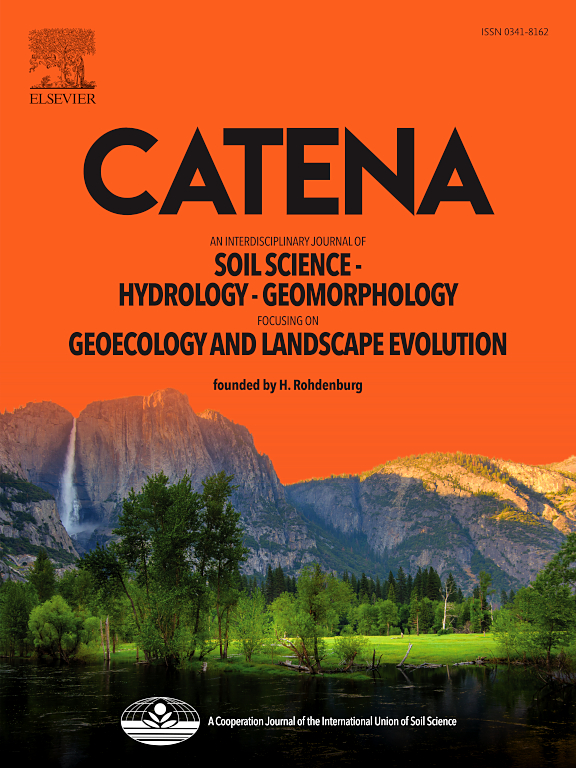Glacier melting phenology changes in the Tibetan Plateau from 1981 to 2020
IF 5.4
1区 农林科学
Q1 GEOSCIENCES, MULTIDISCIPLINARY
引用次数: 0
Abstract
A comprehensive understanding of the spatiotemporal variability of glacier melt phenology across the Tibetan Plateau is crucial due to its significant impacts on hydrological processes, water supply, natural disasters, climate systems, and ecosystems. Key metrics, including glacier melting onset date (GMOD), end date (GMED), duration (GMDD), and accumulated temperature (GMAT), are essential for understanding these impacts. This study investigated these metrics using the fifth-generation European Centre for Medium-Range Weather Forecasts (ECMWF) reanalysis of land surface data (ERA5-Land) for the period 1981–2020. Results indicated that GMOD advanced by 0.05 days⋅a−1, GMED was delayed by 0.12 days⋅a−1, GMDD increased by 0.22 days⋅a−1, and GMAT rose by an average of 0.88 °C⋅a−1. GMDD and GMAT exhibited significantly increasing trends (p < 0.05), indicating accelerating glacier retreat and intensified melt potentially reaching higher elevations. Between 1981 and 2020, notable increases in GMDD and GMAT occurred in the northwestern, northeastern, and southeastern regions of the Tibetan Plateau, especially in the Qilian, Hengduan, and Tanglha Mountains. A significant positive correlation existed between GMOD and elevation, while GMED, GMDD, and GMAT exhibited negative correlations. Smaller glaciers showed considerable increases in GMDD, medium-scale glaciers displayed significant delays in GMED, and larger glaciers demonstrated marked increases in GMAT. Additionally, debris-covered glaciers exhibited earlier melt onset and extended melt durations, with debris’ insulating effect influencing temporal and spatial changes in melt phenology. Net longwave radiation was a key meteorological factor influencing glacial melting phenology, with ENSO and AMO significantly affecting these changes.
1981 - 2020年青藏高原冰川融化物候变化
青藏高原冰川融化物候的时空变化对水文过程、供水、自然灾害、气候系统和生态系统具有重要影响,因此全面了解青藏高原冰川融化物候的时空变化至关重要。冰川融化开始日期(GMOD)、结束日期(GMED)、持续时间(GMDD)和积温(GMAT)等关键指标对于理解这些影响至关重要。本研究利用1981-2020年期间欧洲中期天气预报中心(ECMWF)第五代陆地表面数据再分析(ERA5-Land)对这些指标进行了调查。结果表明,GMOD提前0.05天⋅a−1,GMED延迟0.12天⋅a−1,GMDD升高0.22天⋅a−1,GMAT平均升高0.88°C⋅a−1。GMDD和GMAT呈显著上升趋势(p <;0.05),表明冰川正在加速退缩,融化加剧,可能到达更高的海拔。1981 - 2020年,青藏高原西北部、东北部和东南部地区,特别是祁连山、横断山和唐拉山地区,GMDD和GMAT显著增加。GMOD与海拔高度呈显著正相关,GMED、GMDD、GMAT呈显著负相关。较小冰川的GMDD显著增加,中等规模冰川的GMED显著延迟,较大冰川的GMAT显著增加。此外,碎屑覆盖的冰川表现出更早的融化开始时间和更长的融化持续时间,碎屑的隔离作用影响了熔体物候的时空变化。净长波辐射是影响冰川消融物候变化的关键气象因子,ENSO和AMO对其影响显著。
本文章由计算机程序翻译,如有差异,请以英文原文为准。
求助全文
约1分钟内获得全文
求助全文
来源期刊

Catena
环境科学-地球科学综合
CiteScore
10.50
自引率
9.70%
发文量
816
审稿时长
54 days
期刊介绍:
Catena publishes papers describing original field and laboratory investigations and reviews on geoecology and landscape evolution with emphasis on interdisciplinary aspects of soil science, hydrology and geomorphology. It aims to disseminate new knowledge and foster better understanding of the physical environment, of evolutionary sequences that have resulted in past and current landscapes, and of the natural processes that are likely to determine the fate of our terrestrial environment.
Papers within any one of the above topics are welcome provided they are of sufficiently wide interest and relevance.
 求助内容:
求助内容: 应助结果提醒方式:
应助结果提醒方式:


